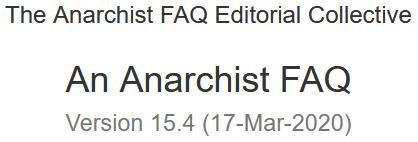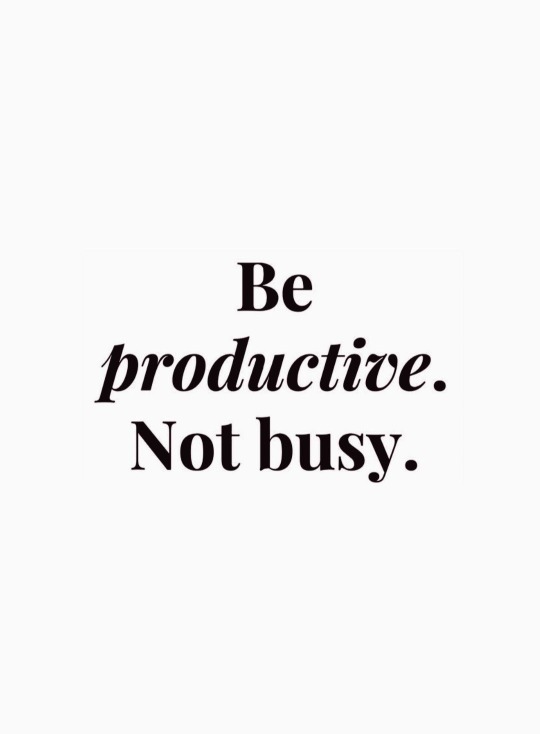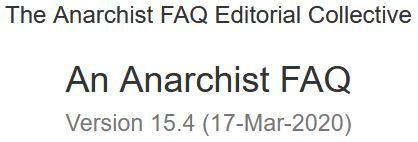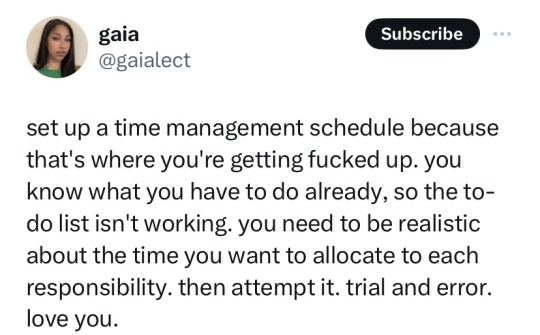#Organization
Text
#2pac#protein#spiderman into the spiderverse#pokemon go#acnh#organization#erica mena#the owl house fanart#hanji zoe#snacks
121 notes
·
View notes
Text

A.3.5 What is Anarcha-Feminism?
Although opposition to the state and all forms of authority had a strong voice among the early feminists of the 19th century, the more recent feminist movement which began in the 1960’s was founded upon anarchist practice. This is where the term anarcha-feminism came from, referring to women anarchists who act within the larger feminist and anarchist movements to remind them of their principles.
The modern anarcha-feminists built upon the feminist ideas of previous anarchists, both male and female. Indeed, anarchism and feminism have always been closely linked. Many outstanding feminists have also been anarchists, including the pioneering Mary Wollstonecraft (author of A Vindication of the Rights of Woman), the Communard Louise Michel, and the American anarchists (and tireless champions of women’s freedom) Voltairine de Cleyre and Emma Goldman (for the former, see her essays “Sex Slavery”, “Gates of Freedom”, “The Case of Woman vs. Orthodoxy”, “Those Who Marry Do Ill”; for the latter see “The Traffic in Women”, “Woman Suffrage”, “The Tragedy of Woman’s Emancipation”, “Marriage and Love” and “Victims of Morality”, for example). Freedom, the world’s oldest anarchist newspaper, was founded by Charlotte Wilson in 1886. Anarchist women like Virgilia D’Andrea and Rose Pesota played important roles in both the libertarian and labour movements. The “Mujeres Libres” (“Free Women”) movement in Spain during the Spanish revolution is a classic example of women anarchists organising themselves to defend their basic freedoms and create a society based on women’s freedom and equality (see Free Women of Spain by Martha Ackelsberg for more details on this important organisation). In addition, all the male major anarchist thinkers (bar Proudhon) were firm supporters of women’s equality. For example, Bakunin opposed patriarchy and how the law “subjects [women] to the absolute domination of the man.” He argued that ”[e]qual rights must belong to men and women” so that women can “become independent and be free to forge their own way of life.” He looked forward to the end of “the authoritarian juridical family” and “the full sexual freedom of women.” [Bakunin on Anarchism, p. 396 and p. 397]
Thus anarchism has since the 1860s combined a radical critique of capitalism and the state with an equally powerful critique of patriarchy (rule by men). Anarchists, particularly female ones, recognised that modern society was dominated by men. As Ana Maria Mozzoni (an Italian anarchist immigrant in Buenos Aires) put it, women “will find that the priest who damns you is a man; that the legislator who oppresses you is a man, that the husband who reduces you to an object is a man; that the libertine who harasses you is a man; that the capitalist who enriches himself with your ill-paid work and the speculator who calmly pockets the price of your body, are men.” Little has changed since then. Patriarchy still exists and, to quote the anarchist paper La Questione Sociale, it is still usually the case that women “are slaves both in social and private life. If you are a proletarian, you have two tyrants: the man and the boss. If bourgeois, the only sovereignty left to you is that of frivolity and coquetry.” [quoted by Jose Moya, Italians in Buenos Aires’s Anarchist Movement, pp. 197–8 and p. 200]
Anarchism, therefore, is based on an awareness that fighting patriarchy is as important as fighting against the state or capitalism. For ”[y]ou can have no free, or just, or equal society, nor anything approaching it, so long as womanhood is bought, sold, housed, clothed, fed, and protected, as a chattel.” [Voltairine de Cleyre, “The Gates of Freedom”, pp. 235–250, Eugenia C. Delamotte, Gates of Freedom, p. 242] To quote Louise Michel:
“The first thing that must change is the relationship between the sexes. Humanity has two parts, men and women, and we ought to be walking hand in hand; instead there is antagonism, and it will last as long as the ‘stronger’ half controls, or think its controls, the ‘weaker’ half.” [The Red Virgin: Memoirs of Louise Michel, p. 139]
Thus anarchism, like feminism, fights patriarchy and for women’s equality. Both share much common history and a concern about individual freedom, equality and dignity for members of the female sex (although, as we will explain in more depth below, anarchists have always been very critical of mainstream/liberal feminism as not going far enough). Therefore, it is unsurprising that the new wave of feminism of the sixties expressed itself in an anarchistic manner and drew much inspiration from anarchist figures such as Emma Goldman. Cathy Levine points out that, during this time, “independent groups of women began functioning without the structure, leaders, and other factotums of the male left, creating, independently and simultaneously, organisations similar to those of anarchists of many decades and regions. No accident, either.” [“The Tyranny of Tyranny,” Quiet Rumours: An Anarcha-Feminist Reader, p. 66] It is no accident because, as feminist scholars have noted, women were among the first victims of hierarchical society, which is thought to have begun with the rise of patriarchy and ideologies of domination during the late Neolithic era. Marilyn French argues (in Beyond Power) that the first major social stratification of the human race occurred when men began dominating women, with women becoming in effect a “lower” and “inferior” social class.
The links between anarchism and modern feminism exist in both ideas and action. Leading feminist thinker Carole Pateman notes that her “discussion [on contract theory and its authoritarian and patriarchal basis] owes something to” libertarian ideas, that is the “anarchist wing of the socialist movement.” [The Sexual Contract, p. 14] Moreover, she noted in the 1980s how the “major locus of criticism of authoritarian, hierarchical, undemocratic forms of organisation for the last twenty years has been the women’s movement … After Marx defeated Bakunin in the First International, the prevailing form of organisation in the labour movement, the nationalised industries and in the left sects has mimicked the hierarchy of the state … The women’s movement has rescued and put into practice the long-submerged idea [of anarchists like Bakunin] that movements for, and experiments in, social change must ‘prefigure’ the future form of social organisation.” [The Disorder of Women, p. 201]
Peggy Kornegger has drawn attention to these strong connections between feminism and anarchism, both in theory and practice. “The radical feminist perspective is almost pure anarchism,” she writes. “The basic theory postulates the nuclear family as the basis of all authoritarian systems. The lesson the child learns, from father to teacher to boss to god, is to obey the great anonymous voice of Authority. To graduate from childhood to adulthood is to become a full-fledged automaton, incapable of questioning or even of thinking clearly.” [“Anarchism: The Feminist Connection,” Quiet Rumours: An Anarcha-Feminist Reader, p. 26] Similarly, the Zero Collective argues that Anarcha-feminism “consists in recognising the anarchism of feminism and consciously developing it.” [“Anarchism/Feminism,” pp. 3–7, The Raven, no. 21, p. 6]
Anarcha-feminists point out that authoritarian traits and values, for example, domination, exploitation, aggressiveness, competitiveness, desensitisation etc., are highly valued in hierarchical civilisations and are traditionally referred to as “masculine.” In contrast, non-authoritarian traits and values such as co-operation, sharing, compassion, sensitivity, warmth, etc., are traditionally regarded as “feminine” and are devalued. Feminist scholars have traced this phenomenon back to the growth of patriarchal societies during the early Bronze Age and their conquest of co-operatively based “organic” societies in which “feminine” traits and values were prevalent and respected. Following these conquests, however, such values came to be regarded as “inferior,” especially for a man, since men were in charge of domination and exploitation under patriarchy. (See e.g. Riane Eisler, The Chalice and the Blade; Elise Boulding, The Underside of History). Hence anarcha-feminists have referred to the creation of a non-authoritarian, anarchist society based on co-operation, sharing, mutual aid, etc. as the “feminisation of society.”
Anarcha-feminists have noted that “feminising” society cannot be achieved without both self-management and decentralisation. This is because the patriarchal-authoritarian values and traditions they wish to overthrow are embodied and reproduced in hierarchies. Thus feminism implies decentralisation, which in turn implies self-management. Many feminists have recognised this, as reflected in their experiments with collective forms of feminist organisations that eliminate hierarchical structure and competitive forms of decision making. Some feminists have even argued that directly democratic organisations are specifically female political forms. [see e.g. Nancy Hartsock “Feminist Theory and the Development of Revolutionary Strategy,” in Zeila Eisenstein, ed., Capitalist Patriarchy and the Case for Socialist Feminism, pp. 56–77] Like all anarchists, anarcha-feminists recognise that self-liberation is the key to women’s equality and thus, freedom. Thus Emma Goldman:
“Her development, her freedom, her independence, must come from and through herself. First, by asserting herself as a personality, and not as a sex commodity. Second, by refusing the right of anyone over her body; by refusing to bear children, unless she wants them, by refusing to be a servant to God, the State, society, the husband, the family, etc., by making her life simpler, but deeper and richer. That is, by trying to learn the meaning and substance of life in all its complexities; by freeing herself from the fear of public opinion and public condemnation.” [Anarchism and Other Essays, p. 211]
Anarcha-feminism tries to keep feminism from becoming influenced and dominated by authoritarian ideologies of either the right or left. It proposes direct action and self-help instead of the mass reformist campaigns favoured by the “official” feminist movement, with its creation of hierarchical and centralist organisations and its illusion that having more women bosses, politicians, and soldiers is a move towards “equality.” Anarcha-feminists would point out that the so-called “management science” which women have to learn in order to become mangers in capitalist companies is essentially a set of techniques for controlling and exploiting wage workers in corporate hierarchies, whereas “feminising” society requires the elimination of capitalist wage-slavery and managerial domination altogether. Anarcha-feminists realise that learning how to become an effective exploiter or oppressor is not the path to equality (as one member of the Mujeres Libres put it, ”[w]e did not want to substitute a feminist hierarchy for a masculine one” [quoted by Martha A. Ackelsberg, Free Women of Spain, pp. 22–3] — also see section B.1.4 for a further discussion on patriarchy and hierarchy).
Hence anarchism’s traditional hostility to liberal (or mainstream) feminism, while supporting women’s liberation and equality. Federica Montseny (a leading figure in the Spanish Anarchist movement) argued that such feminism advocated equality for women, but did not challenge existing institutions. She argued that (mainstream) feminism’s only ambition is to give to women of a particular class the opportunity to participate more fully in the existing system of privilege and if these institutions “are unjust when men take advantage of them, they will still be unjust if women take advantage of them.” [quoted by Martha A. Ackelsberg, Op. Cit., p. 119] Thus, for anarchists, women’s freedom did not mean an equal chance to become a boss or a wage slave, a voter or a politician, but rather to be a free and equal individual co-operating as equals in free associations. “Feminism,” stressed Peggy Kornegger, “doesn’t mean female corporate power or a woman President; it means no corporate power and no Presidents. The Equal Rights Amendment will not transform society; it only gives women the ‘right’ to plug into a hierarchical economy. Challenging sexism means challenging all hierarchy — economic, political, and personal. And that means an anarcha-feminist revolution.” [Op. Cit., p. 27]
Anarchism, as can be seen, included a class and economic analysis which is missing from mainstream feminism while, at the same time, showing an awareness to domestic and sex-based power relations which eluded the mainstream socialist movement. This flows from our hatred of hierarchy. As Mozzoni put it, “Anarchy defends the cause of all the oppressed, and because of this, and in a special way, it defends your [women’s] cause, oh! women, doubly oppressed by present society in both the social and private spheres.” [quoted by Moya, Op. Cit., p. 203] This means that, to quote a Chinese anarchist, what anarchists “mean by equality between the sexes is not just that the men will no longer oppress women. We also want men to no longer to be oppressed by other men, and women no longer to be oppressed by other women.” Thus women should “completely overthrow rulership, force men to abandon all their special privileges and become equal to women, and make a world with neither the oppression of women nor the oppression of men.” [He Zhen, quoted by Peter Zarrow, Anarchism and Chinese Political Culture, p. 147]
So, in the historic anarchist movement, as Martha Ackelsberg notes, liberal/mainstream feminism was considered as being “too narrowly focused as a strategy for women’s emancipation; sexual struggle could not be separated from class struggle or from the anarchist project as a whole.” [Op. Cit., p. 119] Anarcha-feminism continues this tradition by arguing that all forms of hierarchy are wrong, not just patriarchy, and that feminism is in conflict with its own ideals if it desires simply to allow women to have the same chance of being a boss as a man does. They simply state the obvious, namely that they “do not believe that power in the hands of women could possibly lead to a non-coercive society” nor do they “believe that anything good can come out of a mass movement with a leadership elite.” The “central issues are always power and social hierarchy” and so people “are free only when they have power over their own lives.” [Carole Ehrlich, “Socialism, Anarchism and Feminism”, Quiet Rumours: An Anarcha-Feminist Reader, p. 44] For if, as Louise Michel put it, “a proletarian is a slave; the wife of a proletarian is even more a slave” ensuring that the wife experiences an equal level of oppression as the husband misses the point. [Op. Cit., p. 141]
Anarcha-feminists, therefore, like all anarchists oppose capitalism as a denial of liberty. Their critique of hierarchy in the society does not start and end with patriarchy. It is a case of wanting freedom everywhere, of wanting to ”[b]reak up … every home that rests in slavery! Every marriage that represents the sale and transfer of the individuality of one of its parties to the other! Every institution, social or civil, that stands between man and his right; every tie that renders one a master, another a serf.” [Voltairine de Cleyre, “The Economic Tendency of Freethought”, The Voltairine de Cleyre Reader, p. 72] The ideal that an “equal opportunity” capitalism would free women ignores the fact that any such system would still see working class women oppressed by bosses (be they male or female). For anarcha-feminists, the struggle for women’s liberation cannot be separated from the struggle against hierarchy as such. As L. Susan Brown puts it:
“Anarchist-feminism, as an expression of the anarchist sensibility applied to feminist concerns, takes the individual as its starting point and, in opposition to relations of domination and subordination, argues for non-instrumental economic forms that preserve individual existential freedom, for both men and women.” [The Politics of Individualism, p. 144]
Anarcha-feminists have much to contribute to our understanding of the origins of the ecological crisis in the authoritarian values of hierarchical civilisation. For example, a number of feminist scholars have argued that the domination of nature has paralleled the domination of women, who have been identified with nature throughout history (See, for example, Caroline Merchant, The Death of Nature, 1980). Both women and nature are victims of the obsession with control that characterises the authoritarian personality. For this reason, a growing number of both radical ecologists and feminists are recognising that hierarchies must be dismantled in order to achieve their respective goals.
In addition, anarcha-feminism reminds us of the importance of treating women equally with men while, at the same time, respecting women’s differences from men. In other words, that recognising and respecting diversity includes women as well as men. Too often many male anarchists assume that, because they are (in theory) opposed to sexism, they are not sexist in practice. Such an assumption is false. Anarcha-feminism brings the question of consistency between theory and practice to the front of social activism and reminds us all that we must fight not only external constraints but also internal ones.
This means that anarcha-feminism urges us to practice what we preach. As Voltairine de Cleyre argued, “I never expect men to give us liberty. No, Women, we are not worth it, until we take it.” This involves “insisting on a new code of ethics founded on the law of equal freedom: a code recognising the complete individuality of woman. By making rebels wherever we can. By ourselves living our beliefs . … We are revolutionists. And we shall use propaganda by speech, deed, and most of all life — being what we teach.” Thus anarcha-feminists, like all anarchists, see the struggle against patriarchy as being a struggle of the oppressed for their own self-liberation, for ”as a class I have nothing to hope from men . .. No tyrant ever renounced his tyranny until he had to. If history ever teaches us anything it teaches this. Therefore my hope lies in creating rebellion in the breasts of women.” [“The Gates of Freedom”, pp. 235–250, Eugenia C. Delamotte, Gates of Freedom, p. 249 and p. 239] This was sadly as applicable within the anarchist movement as it was outside it in patriarchal society.
Faced with the sexism of male anarchists who spoke of sexual equality, women anarchists in Spain organised themselves into the Mujeres Libres organisation to combat it. They did not believe in leaving their liberation to some day after the revolution. Their liberation was a integral part of that revolution and had to be started today. In this they repeated the conclusions of anarchist women in Illinois Coal towns who grew tried of hearing their male comrades “shout in favour” of sexual equality “in the future society” while doing nothing about it in the here and now. They used a particularly insulting analogy, comparing their male comrades to priests who “make false promises to the starving masses … [that] there will be rewards in paradise.” The argued that mothers should make their daughters “understand that the difference in sex does not imply inequality in rights” and that as well as being “rebels against the social system of today,” they “should fight especially against the oppression of men who would like to retain women as their moral and material inferior.” [Ersilia Grandi, quoted by Caroline Waldron Merithew, Anarchist Motherhood, p. 227] They formed the “Luisa Michel” group to fight against capitalism and patriarchy in the upper Illinois valley coal towns over three decades before their Spanish comrades organised themselves.
For anarcha-feminists, combating sexism is a key aspect of the struggle for freedom. It is not, as many Marxist socialists argued before the rise of feminism, a diversion from the “real” struggle against capitalism which would somehow be automatically solved after the revolution. It is an essential part of the struggle:
“We do not need any of your titles … We want none of them. What we do want is knowledge and education and liberty. We know what our rights are and we demand them. Are we not standing next to you fighting the supreme fight? Are you not strong enough, men, to make part of that supreme fight a struggle for the rights of women? And then men and women together will gain the rights of all humanity.” [Louise Michel, Op. Cit., p. 142]
A key part of this revolutionising modern society is the transformation of the current relationship between the sexes. Marriage is a particular evil for “the old form of marriage, based on the Bible, ‘till death doth part,’ … [is] an institution that stands for the sovereignty of the man over the women, of her complete submission to his whims and commands.” Women are reduced “to the function of man’s servant and bearer of his children.” [Goldman, Op. Cit., pp. 220–1] Instead of this, anarchists proposed “free love,” that is couples and families based on free agreement between equals than one partner being in authority and the other simply obeying. Such unions would be without sanction of church or state for “two beings who love each other do not need permission from a third to go to bed.” [Mozzoni, quoted by Moya, Op. Cit., p. 200]
Equality and freedom apply to more than just relationships. For “if social progress consists in a constant tendency towards the equalisation of the liberties of social units, then the demands of progress are not satisfied so long as half society, Women, is in subjection… . Woman … is beginning to feel her servitude; that there is a requisite acknowledgement to be won from her master before he is put down and she exalted to — Equality. This acknowledgement is, the freedom to control her own person. “ [Voltairine de Cleyre, “The Gates of Freedom”, Op. Cit., p. 242] Neither men nor state nor church should say what a woman does with her body. A logical extension of this is that women must have control over their own reproductive organs. Thus anarcha-feminists, like anarchists in general, are pro-choice and pro-reproductive rights (i.e. the right of a woman to control her own reproductive decisions). This is a long standing position. Emma Goldman was persecuted and incarcerated because of her public advocacy of birth control methods and the extremist notion that women should decide when they become pregnant (as feminist writer Margaret Anderson put it, “In 1916, Emma Goldman was sent to prison for advocating that ‘women need not always keep their mouth shut and their wombs open.’”).
Anarcha-feminism does not stop there. Like anarchism in general, it aims at changing all aspects of society not just what happens in the home. For, as Goldman asked, “how much independence is gained if the narrowness and lack of freedom of the home is exchanged for the narrowness and lack of freedom of the factory, sweat-shop, department store, or office?” Thus women’s equality and freedom had to be fought everywhere and defended against all forms of hierarchy. Nor can they be achieved by voting. Real liberation, argue anarcha-feminists, is only possible by direct action and anarcha-feminism is based on women’s self-activity and self-liberation for while the “right to vote, or equal civil rights, may be good demands … true emancipation begins neither at the polls nor in the courts. It begins in woman’s soul … her freedom will reach as far as her power to achieve freedom reaches.” [Goldman, Op. Cit., p. 216 and p. 224]
The history of the women’s movement proves this. Every gain has come from below, by the action of women themselves. As Louise Michel put it, ”[w]e women are not bad revolutionaries. Without begging anyone, we are taking our place in the struggles; otherwise, we could go ahead and pass motions until the world ends and gain nothing.” [Op. Cit., p. 139] If women waited for others to act for them their social position would never have changed. This includes getting the vote in the first place. Faced with the militant suffrage movement for women’s votes, British anarchist Rose Witcop recognised that it was “true that this movement shows us that women who so far have been so submissive to their masters, the men, are beginning to wake up at last to the fact they are not inferior to those masters.” Yet she argued that women would not be freed by votes but “by their own strength.” [quoted by Sheila Rowbotham, Hidden from History, pp. 100–1 and p. 101] The women’s movement of the 1960s and 1970s showed the truth of that analysis. In spite of equal voting rights, women’s social place had remained unchanged since the 1920s.
Ultimately, as Anarchist Lily Gair Wilkinson stressed, the “call for ‘votes’ can never be a call to freedom. For what is it to vote? To vote is to register assent to being ruled by one legislator or another?” [quoted by Sheila Rowbotham, Op. Cit., p. 102] It does not get to the heart of the problem, namely hierarchy and the authoritarian social relationships it creates of which patriarchy is only a subset of. Only by getting rid of all bosses, political, economic, social and sexual can genuine freedom for women be achieved and “make it possible for women to be human in the truest sense. Everything within her that craves assertion and activity should reach its fullest expression; all artificial barriers should be broken, and the road towards greater freedom cleared of every trace of centuries of submission and slavery.” [Emma Goldman, Op. Cit., p. 214]
#feminism#anarchy faq#revolution#anarchism#daily posts#communism#anti capitalist#anti capitalism#late stage capitalism#organization#grassroots#grass roots#anarchists#libraries#leftism#social issues#economy#economics#climate change#climate crisis#climate#ecology#anarchy works#environmentalism#environment#solarpunk#anti colonialism#mutual aid#cops#police
24 notes
·
View notes
Text
★ how to declutter your phone ★
i spend a lot of my time on my phone, and most likely you do too (don't worry, i'm not here to call you out). if you never organize or declutter your phone, after a while your storage gets full and you can't find anything on it. here's a list of things you can do to keep your phone looking clean and organized:
⋆ ˚。 ⋆୨♡୧⋆ ˚。 ⋆
✧ move new and unorganized apps into folders
✧ delete all unneeded alarms
✧ delete unneeded photos and videos
✧ delete unneeded screenshots and screen recordings
✧ close all tabs
✧ delete unneeded notes
✧ add upcoming events to calendar
✧ delete unneeded bookmarks on browser
✧ organize apps on homescreen
✧ delete and unsubscribe unneeded emails
✧ organize social media (unfollow people, update profiles)
✧ delete unused apps
✧ organize playlists
⋆ ˚。 ⋆୨♡୧⋆ ˚。 ⋆
if you do all this once a month, or atleast every few months, your phone will stay nice and tidy. it might feel like a big project the first time, but once you start doing this regularly, it'll be much easier and faster. have a great day, stay organized ♡

#coquette#girlblogging#pinterest#this is a girlblog#100 days of productivity#clean girl#girlblog#productivity challenge#that girl#organization#phone case#becoming that girl#decluttering#self care#self development#productivitytips
37 notes
·
View notes
Text

Finally, this drawer of binding supplies is organized! I used scraps of book board and lots of pva adhesive to make this. It makes me very happy because every freaking time I need the little corner spacer thingy, I can never find it.
(And yes, hot tamales are binding supplies.)
20 notes
·
View notes
Text
How to Stop Procrastinating by Managing Your Emotions
Procrastination happens when we delay doing things, and it's often connected to our emotions. Feelings like being afraid to fail, feeling worried or stressed, getting bored, or lacking motivation can all contribute to procrastination. To stop procrastinating and get more things done, it's important to learn how to handle our emotions better.
Boredom:
Break the task into smaller, more engaging sub-tasks.
Find ways to make the task more interesting or challenging.
Set a timer and work on the task for a specific amount of time, followed by a short break doing something enjoyable.
Feeling Overwhelmed:
Prioritize tasks and focus on one thing at a time.
Break the task into smaller, more manageable steps.
Delegate some parts of the task if possible or seek help from others.
Use tools like to-do lists or task management apps to stay organized.
Anxiety:
Practice deep breathing or mindfulness techniques to calm yourself.
Challenge negative thoughts and replace them with more positive and realistic ones.
Start with the easier or less intimidating aspects of the task to build momentum.
Set realistic expectations and remind yourself that it's okay to make mistakes.
Self-Doubt:
Focus on past accomplishments and successes to boost your confidence.
Seek support or feedback from others to gain reassurance.
Remind yourself of your skills and capabilities to tackle the task.
Use positive affirmations to counteract negative self-talk.
Perfectionism:
Embrace the concept of "good enough" rather than seeking perfection.
Set realistic and achievable goals for each task.
Recognize that mistakes and imperfections are part of the learning process and growth.
Indecisiveness:
Break decisions into smaller steps and make one small decision at a time.
Set a time limit for making decisions to avoid overthinking.
Trust your instincts and make the best decision you can with the information available.
Apathy or Lack of Interest:
Find aspects of the task that align with your values or long-term goals.
Break the task into smaller, more manageable parts and focus on completing one at a time.
Reward yourself for completing the task to make it more appealing.
Stress or Burnout:
Practice stress-reduction techniques such as meditation, exercise, or spending time in nature.
Break tasks into smaller steps to reduce the feeling of overwhelm.
Prioritize self-care and take breaks to avoid burnout.
Feeling Uninspired or Creatively Blocked:
Engage in activities that stimulate creativity, such as brainstorming, mind mapping, or seeking inspiration from others' work.
Start with a simple and basic version of the task to get the creative juices flowing.
Collaborate with others or seek feedback to gain new perspectives.
Fear of Success:
Identify and challenge the negative beliefs or fears that may be holding you back.
Visualize the positive outcomes of completing the task successfully.
Focus on the benefits and personal growth that come with success.
Impatience:
Break long-term goals into smaller milestones to track progress.
Practice mindfulness to stay present and patient throughout the process.
Remind yourself that progress takes time and effort.
Lack of Confidence:
Celebrate your past accomplishments to boost your confidence.
Seek support and encouragement from friends, family, or mentors.
Focus on building specific skills related to the task to increase confidence.
Avoiding Discomfort:
Acknowledge that discomfort is a natural part of growth and improvement.
Break tasks into smaller steps and tackle the more challenging aspects gradually.
Remind yourself of the long-term benefits of facing discomfort.
Overestimating Future Motivation:
Practice discipline and commit to starting tasks even when motivation is low.
Set specific deadlines for tasks to create a sense of urgency.
Establish a routine that includes regular work on the task to build consistency.
#discipline#motivationalquotes#motivateyourself#get motivated#organization#procrastination#emotional intelligence#self improvement#selfimprovement#self love#self development#personal improvement#personal growth#personal development#level up journey#success mindset#positive mindset#business mindset#goalsetting#life goals
8K notes
·
View notes
Text
getting seriously organized⋆.ೃ࿔*:・📄

the importance of organization - the nature of life is that it can seem really disorganized and chaotic but it doesn't absolutely have to be that way! organization helps to improve your efficiency and overall add structure to ur life.
agendas - a daily to do list is a MUST. i use notion to organize my time. i separate what i need to do into categories (A and B).

CATEGORY A ; tasks that hold the highest level of importance.
CATEGORY B ; tasks that are more simple (its not gonna nip u in the bud if u dont do a task in category b)
monthly calendars - monthly calendars are so helpful because i set new goals for every month, and when everything is already planned out and in front of you it makes it feel a million times easier to achieve those goals.
list important events
birthdays
appointments etc
lists - making lists is therapeutic for me at this point. its actually a lot of fun so i highly recommend it, but instead of just making lists for fun, you could make lists that'll be useful in the future. for example...
restock lists (lists of things that you consistently need and use)
grocery lists
meal prep - meal prep is so useful because it makes grocery shopping easier, and its easier to eat consistently when u know what ur going to eat
#advice#it girl#becoming that girl#that girl#it girl energy#honeytonedhottie⭐️#organization#self discipline#self development#self improvement#productivity#dream girl tips#dream girl#dream life#notion✍🏽🎀#pink academia#girl blog#girlblogging#calendars#planner#time management#self management
803 notes
·
View notes
Text









#feminine energy#leveled up mindset#luxury black women#black luxury#black femininity#black girl luxury#soft moodboard#black girl moodboard#moodboard#organization#high maintenance#luxury#rich black girls#soft black women#career development#career journey
574 notes
·
View notes
Text

Good morning, StudyBlrs.
EXAM DAY:
I woke up early today to revise some questions that might be asked in my surgery exam. I go to classes and I try to understand what the teacher is focusing on more. I always ask questions. I will let you know how it went.
I had no coffee today because I have noticed that on exam days I already have my adrenaline and energy up. So, I had a cup of tea and my banana for snack two hours after my proper breakfast.
@studywith-hada made this cool study with me video and I have used it today. So cool.
TODAY:
I decided to start my day with Neurophysiology.
I made a three tasks list and I will be using (as usual) my Korean study tracking.
Let's do this!


Have a blessed and productive week! :)
Iveth🌻
#she studies medicine#medical studyblr#studyblr#studyblr community#study blog#medical student#studystudystudy#100 days of efficient productivity challenge#studyspo#studygram#study#studying#study motivation#study notes#study tips#organization
383 notes
·
View notes
Text
Can't overemphasize how useful it is to own multiples of important things.
Deodorant? One in the bathroom and one in my closet, because those are the places I'm most likely to be naked and remember I need it. Lotion? One in the bathroom and one next to my bed, also because those are the places I remember it. I keep an air freshener in the bathroom and another one next to the place where I air out my sweaty work clothes.
I have one inhaler in my backpack, one in my car, and one in my leg bag. Hair clips, headbands, and hair ties? Some on the wall hooks in my room, others looped around the car gearshift. Teriyaki sauce? A bottle in the kitchen fridge, and packets in my room in case I forget the bottle.
Yeah it's redundant, but I promise that the two-pack of deodorant "costs" less to me than spending a day sticky and damp. It isn't wasteful if the system makes you use the thing. Even the bowl on my desk for pocket stuff (knife phone wallet keys) has a spare car key in case I misplace the original.
People who expect me to remember stuff are wrong. I do what keeps me clean and fed and happy.
242 notes
·
View notes
Text






years in planners
Found my old Hobonichi Techo and decided to scan my favourite pages from the last 3 years in planners. From my third year of uni till the last one, 2021-2023. Starting with my 2021 bullet journal and ending on this year’s planner/filofax
#studyblr#studygram#studying#studyspo#mine#study#studymotivation#student#university#studyday#bulletjounaladdict#bulletjournal#bullet journal#bujo#planner#filofax#student life#organization
386 notes
·
View notes
Text

A.1.4 Are anarchists socialists?
Yes. All branches of anarchism are opposed to capitalism. This is because capitalism is based upon oppression and exploitation (see sections B and C). Anarchists reject the “notion that men cannot work together unless they have a driving-master to take a percentage of their product” and think that in an anarchist society “the real workmen will make their own regulations, decide when and where and how things shall be done.” By so doing workers would free themselves “from the terrible bondage of capitalism.” [Voltairine de Cleyre, “Anarchism”, Exquisite Rebel, p. 75 and p. 79]
(We must stress here that anarchists are opposed to all economic forms which are based on domination and exploitation, including feudalism, Soviet-style “socialism” — better called “state capitalism” --, slavery and so on. We concentrate on capitalism because that is what is dominating the world just now).
Individualists like Benjamin Tucker along with social anarchists like Proudhon and Bakunin proclaimed themselves “socialists.” They did so because, as Kropotkin put it in his classic essay “Modern Science and Anarchism,” ”[s]o long as Socialism was understood in its wide, generic, and true sense — as an effort to abolish the exploitation of Labour by Capital — the Anarchists were marching hand-in-hands with the Socialists of that time.” [Evolution and Environment, p. 81] Or, in Tucker’s words, “the bottom claim of Socialism [is] that labour should be put in possession of its own,” a claim that both “the two schools of Socialistic thought … State Socialism and Anarchism” agreed upon. [The Anarchist Reader, p. 144] Hence the word “socialist” was originally defined to include “all those who believed in the individual’s right to possess what he or she produced.” [Lance Klafta, “Ayn Rand and the Perversion of Libertarianism,” in Anarchy: A Journal of Desire Armed, no. 34] This opposition to exploitation (or usury) is shared by all true anarchists and places them under the socialist banner.
For most socialists, “the only guarantee not to be robbed of the fruits of your labour is to possess the instruments of labour.” [Peter Kropotkin, The Conquest of Bread, p. 145] For this reason Proudhon, for example, supported workers’ co-operatives, where “every individual employed in the association … has an undivided share in the property of the company” because by “participation in losses and gains … the collective force [i.e. surplus] ceases to be a source of profits for a small number of managers: it becomes the property of all workers.” [The General Idea of the Revolution, p. 222 and p. 223] Thus, in addition to desiring the end of exploitation of labour by capital, true socialists also desire a society within which the producers own and control the means of production (including, it should be stressed, those workplaces which supply services). The means by which the producers will do this is a moot point in anarchist and other socialist circles, but the desire remains a common one. Anarchists favour direct workers’ control and either ownership by workers’ associations or by the commune (see section A.3 on the different types of anarchists).
Moreover, anarchists also reject capitalism for being authoritarian as well as exploitative. Under capitalism, workers do not govern themselves during the production process nor have control over the product of their labour. Such a situation is hardly based on equal freedom for all, nor can it be non-exploitative, and is so opposed by anarchists. This perspective can best be found in the work of Proudhon’s (who inspired both Tucker and Bakunin) where he argues that anarchism would see ”[c]apitalistic and proprietary exploitation stopped everywhere [and] the wage system abolished” for “either the workman.. . will be simply the employee of the proprietor-capitalist-promoter; or he will participate … In the first case the workman is subordinated, exploited: his permanent condition is one of obedience… In the second case he resumes his dignity as a man and citizen… he forms part of the producing organisation, of which he was before but the slave … we need not hesitate, for we have no choice… it is necessary to form an ASSOCIATION among workers … because without that, they would remain related as subordinates and superiors, and there would ensue two… castes of masters and wage-workers, which is repugnant to a free and democratic society.” [Op. Cit., p. 233 and pp. 215–216]
Therefore all anarchists are anti-capitalist (“If labour owned the wealth it produced, there would be no capitalism” [Alexander Berkman, What is Anarchism?, p. 44]). Benjamin Tucker, for example — the anarchist most influenced by liberalism (as we will discuss later) — called his ideas “Anarchistic-Socialism” and denounced capitalism as a system based upon “the usurer, the receiver of interest, rent and profit.” Tucker held that in an anarchist, non-capitalist, free-market society, capitalists will become redundant and exploitation of labour by capital would cease, since “labour… will… secure its natural wage, its entire product.” [The Individualist Anarchists, p. 82 and p. 85] Such an economy will be based on mutual banking and the free exchange of products between co-operatives, artisans and peasants. For Tucker, and other Individualist anarchists, capitalism is not a true free market, being marked by various laws and monopolies which ensure that capitalists have the advantage over working people, so ensuring the latter’s exploitation via profit, interest and rent (see section G for a fuller discussion). Even Max Stirner, the arch-egoist, had nothing but scorn for capitalist society and its various “spooks,” which for him meant ideas that are treated as sacred or religious, such as private property, competition, division of labour, and so forth.
So anarchists consider themselves as socialists, but socialists of a specific kind — libertarian socialists. As the individualist anarchist Joseph A. Labadie puts it (echoing both Tucker and Bakunin):
“It is said that Anarchism is not socialism. This is a mistake. Anarchism is voluntary Socialism. There are two kinds of Socialism, archistic and anarchistic, authoritarian and libertarian, state and free. Indeed, every proposition for social betterment is either to increase or decrease the powers of external wills and forces over the individual. As they increase they are archistic; as they decrease they are anarchistic.” [Anarchism: What It Is and What It Is Not]
Labadie stated on many occasions that “all anarchists are socialists, but not all socialists are anarchists.” Therefore, Daniel Guerin’s comment that “Anarchism is really a synonym for socialism. The anarchist is primarily a socialist whose aim is to abolish the exploitation of man by man” is echoed throughout the history of the anarchist movement, be it the social or individualist wings. [Anarchism, p. 12] Indeed, the Haymarket Martyr Adolph Fischer used almost exactly the same words as Labadie to express the same fact — “every anarchist is a socialist, but every socialist is not necessarily an anarchist” — while acknowledging that the movement was “divided into two factions; the communistic anarchists and the Proudhon or middle-class anarchists.” [The Autobiographies of the Haymarket Martyrs, p. 81]
So while social and individualist anarchists do disagree on many issues — for example, whether a true, that is non-capitalist, free market would be the best means of maximising liberty — they agree that capitalism is to be opposed as exploitative and oppressive and that an anarchist society must, by definition, be based on associated, not wage, labour. Only associated labour will “decrease the powers of external wills and forces over the individual” during working hours and such self-management of work by those who do it is the core ideal of real socialism. This perspective can be seen when Joseph Labadie argued that the trade union was “the exemplification of gaining freedom by association” and that ”[w]ithout his union, the workman is much more the slave of his employer than he is with it.” [Different Phases of the Labour Question]
However, the meanings of words change over time. Today “socialism” almost always refers to state socialism, a system that all anarchists have opposed as a denial of freedom and genuine socialist ideals. All anarchists would agree with Noam Chomsky’s statement on this issue:
“If the left is understood to include ‘Bolshevism,’ then I would flatly dissociate myself from the left. Lenin was one of the greatest enemies of socialism.” [Marxism, Anarchism, and Alternative Futures, p. 779]
Anarchism developed in constant opposition to the ideas of Marxism, social democracy and Leninism. Long before Lenin rose to power, Mikhail Bakunin warned the followers of Marx against the “Red bureaucracy” that would institute “the worst of all despotic governments” if Marx’s state-socialist ideas were ever implemented. Indeed, the works of Stirner, Proudhon and especially Bakunin all predict the horror of state Socialism with great accuracy. In addition, the anarchists were among the first and most vocal critics and opposition to the Bolshevik regime in Russia.
Nevertheless, being socialists, anarchists do share some ideas with some Marxists (though none with Leninists). Both Bakunin and Tucker accepted Marx’s analysis and critique of capitalism as well as his labour theory of value (see section C). Marx himself was heavily influenced by Max Stirner’s book The Ego and Its Own, which contains a brilliant critique of what Marx called “vulgar” communism as well as state socialism. There have also been elements of the Marxist movement holding views very similar to social anarchism (particularly the anarcho-syndicalist branch of social anarchism) — for example, Anton Pannekoek, Rosa Luxembourg, Paul Mattick and others, who are very far from Lenin. Karl Korsch and others wrote sympathetically of the anarchist revolution in Spain. There are many continuities from Marx to Lenin, but there are also continuities from Marx to more libertarian Marxists, who were harshly critical of Lenin and Bolshevism and whose ideas approximate anarchism’s desire for the free association of equals.
Therefore anarchism is basically a form of socialism, one that stands in direct opposition to what is usually defined as “socialism” (i.e. state ownership and control). Instead of “central planning,” which many people associate with the word “socialism,” anarchists advocate free association and co-operation between individuals, workplaces and communities and so oppose “state” socialism as a form of state capitalism in which ”[e]very man [and woman] will be a wage-receiver, and the State the only wage payer.” [Benjamin Tucker, The Individualist Anarchists, p. 81] Thus anarchists reject Marxism (what most people think of as “socialism”) as just ”[t]he idea of the State as Capitalist, to which the Social-Democratic fraction of the great Socialist Party is now trying to reduce Socialism.” [Peter Kropotkin, The Great French Revolution, vol. 1, p. 31] The anarchist objection to the identification of Marxism, “central planning” and State Socialism/Capitalism with socialism will be discussed in section H.
It is because of these differences with state socialists, and to reduce confusion, most anarchists just call themselves “anarchists,” as it is taken for granted that anarchists are socialists. However, with the rise of the so-called “libertarian” right in the USA, some pro-capitalists have taken to calling themselves “anarchists” and that is why we have laboured the point somewhat here. Historically, and logically, anarchism implies anti-capitalism, i.e. socialism, which is something, we stress, that all anarchists have agreed upon (for a fuller discuss of why “anarcho”-capitalism is not anarchist see section F).
#faq#anarchy faq#revolution#anarchism#daily posts#communism#anti capitalist#anti capitalism#late stage capitalism#organization#grassroots#grass roots#anarchists#libraries#leftism#social issues#economy#economics#climate change#climate crisis#climate#ecology#anarchy works#environmentalism#environment#solarpunk#anti colonialism#mutual aid#cops#police
17 notes
·
View notes
Text
Hi everyone
I just thought I would share this resources because it is mind blowing.
youtube
This girl has ADHD and talked about how she has always struggled with time blocking and keeping a calendar. She created a new method that works better for her.
Instead of having different coloured colours calendar for different areas of your life and then struggling to know what to do with events that belong to multiple areas. It works by having different colours for each calendar that helps you prioritise tasks. I myself have a hard time deciding what's important.
I have outlined my modified calendars that make sense for me but check out the video for hers.
Appointments
This calendar is for time sensitive things that have be done and/or would have a negative impact on others if you don't follow through. These can't be moved or would be really difficult to move.
Examples: actual appointments, work shifts, classes, scheduled group rehearsals/trainings, someone's birthday dinner/party
Bottlenecks
This calendar is for things that don't need to be done AT a specific time but do need to be done BY a specific time. This means they can be moved around whenever before the deadline but need to be done before the deadline otherwise they create a bottleneck in your schedule and lead to you getting overwhelmed.
Example: homework, taking the bins out, paying bills, filming youtube videos
Critical (yellow)
This calendar is for things that you deem critical to your goals and growth. These can be moved around if needed but are things you want to try your best to get done each day.
Examples: workouts, reading 10 pages of a book, doing a full skincare routine
Daily Routine
This calendar is for parts of your day that happen regularly. These can be moved around where needed.
Examples: habits, chores, meals, travel time
Extra Fancy
This calendar is for extra fancy stuff that your ideal self would like to get done. These are nice to do or want to do but nothing bad will happen if you don't do them.
Examples: doing a facemask, watching a movie, doing some arts and crafts
Favourable Rememberables
This calendar is for things that you need to remember in the future.
Examples: birthdays, days off, due dates (I recommend creating separate events for submitting assessments or paying the bill and put them as appointments which are your top priority)
I hope this can be useful to someone because I think it will have a big difference for me. 💗
#adhd#time management#studyblr#executive dysfunction#adhd brain#neurodiverse stuff#adhd problems#adult adhd#adhd things#adhd stuff#actually adhd#organization#organisation#planner#planning#scheduled#school#university#adulting#study motivation#google calendar#calendar#study tips#life hacks#college#procrastination#Youtube
790 notes
·
View notes
Photo


22nd March: I've fallen into the trap of getting a shoulder bag for uni because they look cute, but despite the shoulder pain, at least everything fits :')
1K notes
·
View notes
Text
How To Plan Your Day 🌒📝💡✨
Start the night before. What do you need to do tomorrow to meet your needs? Write down the most important tasks you want to complete the next day. This gives you a clear starting point in the morning.
Create a morning routine that is focused on your well being. Exercise, meditate, read etc.
Make a list of all the things you need to do. Put the most important things at the top of the list.
Divide your day into chunks of time. Decide when you'll do each task.
Estimate the time it will take you to complete each task.
If a big task seems too hard, break it into smaller steps.
Batch the similar tasks together for maximum efficiency.
Try to do one thing at a time. Multitasking might not help you get things done better.
Don't plan too many things. Only plan what you can really do.
Check your progress during the day. Change your plans if things are not going as expected.
At the end of the day, think about what you did and what's left. Learn from what went well and what didn't.
Finish each day with a quick clean up. What can do you now to set up your spaces and routines for both self care and efficiency.
Choose what you'll wear the next day, including clothes, shoes, and accessories. This saves you time in the morning and helps you avoid last-minute outfit decisions.
If you have to take things with you (like a work bag or gym bag), pack it with everything you need. This prevents you from rushing around in the morning to gather your things.
Lay out items you'll need in the morning, like your keys, wallet, or important papers. This way, you won't have to search for them when you're in a rush.
Take some time to wind down before bed. Read a book, practice some light stretching, or do something relaxing to help you sleep better.
Charge your phone, tablet, or laptop overnight so you start the day with fully charged devices.
Set your alarm for the time you want to wake up. Having a consistent wake-up time helps regulate your body clock.
Try to avoid looking at screens (phones, tablets, computers) at least an hour before bed. The blue light from screens can interfere with sleep.
Take a moment to reflect on the day and think about what you're looking forward to tomorrow. Visualizing a positive morning can help set a good tone for the next day.
Pick a weekly prep day and clean the house, meal prep, review your calendar and to do list for the week ahead.
#personal improvement#personal development#personal growth#morning routine#night time routine#planning#organization#glow up tips#self reflection#self development#self help#self improvement#selfimprovement#self care#it girl#clean girl#dream girl#girlblogging#dream girl journey#dream girl tips#advice#level up journey#goals
2K notes
·
View notes
Text
restocking and replenishing⋆.ೃ࿔*:・✍🏽

im making this post cuz i think its helpful to keep track of what u normally need and normally buy + how long it lasts u until it needs to be replaced.


i separate mine weekly/monthly depending on what it is that i need, but by creating a sort of system like this u can save a lot of time when u go shopping, plus it'll bring ur organization to the next level.
HOW TO DO IT ;
so get some paper (preferably graphed paper, simply bcuz i find it neater and more aesthetically pleasing) and on one side write weekly and on the other side write monthly.
remember to use scented glitter gel pens and have FUN, make little doodles on the sides and decorate it with stickers when ur done.
on the weekly side write out what u need on a weekly basis. for example one thing on the weekly side of my list is sheet masks cuz i use them 1-2x a week.
use bullet points so that then everything is concise and easy to read, also when u go and buy them make sure to write the prices of those items, then u can use that data if u have other charts or lists ✨
on the monthly side write out what u need on a monthly basis. for example one thing on the monthly side of my list are my vitamins and my chlorophyll droplets.
DESIGNATE A DAY ;
have a designated day when u usually go and get whatever is on ur restock and replenish list. have some fun with it and make it a tradition of sorts even.
ur designated day should preferably be before ur week/month starts so that then u are fully equipped with what u need to feel and perform at ur best
my designated day is USUALLY saturdays and on my restock and replenish days i always have a kombucha and treat myself to something else that i want.
#honeytonedhottie⭐️#it girl#becoming that girl#self concept#self care#self love#that girl#it girl energy#dream girl#dream girl tips#dream life#organization#organization tips#self improvement#self reflection#self development#finance#tracking#lists#hyper femininity#girly#girl blogging#girl blog#romanticize
201 notes
·
View notes
